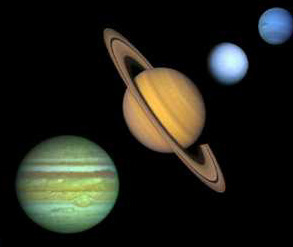Jupiter and Saturn which are the fifth and sixth planets out from the Sun are the giant planets in the solar system. Do you know that Jupiter is actually twice as heavy as all the other planets put together!
In addition, Jupiter is also 1300 times as big as the Earth. Hence, it is the largest planet in the solar system. Jupiter also has a ring system like Saturn but much, much smaller. High-speed winds whirl round Jupiter's surface, creating bands of cloud in the atmosphere.
* Interesting facts!
Do you know that Jupiter actually has 16 moons - 4 big ones which are discovered by Galileo as long ago as 1610 and thus these four moons are named after him the Galilean moons, and there are also 12 small ones.
- What is Jupiter's red spot?
The Great Red Spot or GRS is a huge swirling storm in Jupiter's atmosphere 40000 km across that has gone on in the same place for at least 330 years.
- Do you know how fast does Jupiter revolve on its axis?
Jupiter revolves on its axis faster than any other planets. Despite its huge size, it turns right round in just 9.8 hours, which means the surface is actually moving at an incredibly speed of 45 000 kph!
- Could you land on Jupiter?
Based on scientific research, even if your spaceship could withstand the enormous pressures, there is no surface to land on as the atmosphere merges unnoticeably into deep oceans of liquid hydrogen.
Now, let's watch an documentary on Jupiter. Enjoy!
- Saturn
 Saturn is almost as big as Jupiter. Unlike the inner planets, both Jupiter and Saturn are made largely of Hydrogen and Helium and only their very core is rocky. This does not mean that they are vast cloud balls. However, it tells us that the enormous pressure of gravity means the gas is squeezed until it becomes liquid and even solid.
Saturn is almost as big as Jupiter. Unlike the inner planets, both Jupiter and Saturn are made largely of Hydrogen and Helium and only their very core is rocky. This does not mean that they are vast cloud balls. However, it tells us that the enormous pressure of gravity means the gas is squeezed until it becomes liquid and even solid.Saturn may be very big but because that it is mainly made of liquid hydrogen, it is also remarkably light with an unbelievable mass of 600 billion trillion tonnes! So this means that if you can find a big enough bathtub, Saturn would float on it!
Saturn also has rings which are made of billions of tiny chips of dust and ice - few of them are even bigger than a refrigerator and most the size of ice cubes. These rings are extremely thin - no more than 50 m deep, yet they stretch all the way above Saturn's clouds, and 7000 km high and over 74000 km out into the space. Do you know that one of Saturn's rings is actually as thin as a piece of tissue paper being stretched over a football pitch!
Saturn's winds are actually even faster than Jupiter's and roar round the planet up to an amazing speed of 1800 kph. However, Neptune's wind speed is fastest!
- Do you know how many moons does Saturn have?
Saturn has at least 18 moons including Lapetus which is black on one side and white on the other side. In addition, one of its moons which is Enceladus is actually covered in shiny beads of ice and shimmers like a cinema screen.
- The Cassini division!
Saturn's rings occur in broad bands labelled with the letters A to G. In 1675, the astronomer Cassini spotted a dark gap between the rings A and B which is now called after him, the Cassini division.
Here is an interesting documentary on Saturn. Enjoy!





0 comments:
Post a Comment